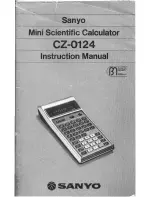
12 Getting Started
by an operation key. Pressing the
I
key is optional after entering a
number, if the next key pressed is an operation. Each time you press an oper-
ation or function key in RPN, the answer is calculated immediately and dis-
played. For example, suppose you wanted to add two numbers in RPN, 1
and 2. Press
1I2+
. The result,
3.00
, is calculated and dis-
played immediately.
There are four special registers used for storing numbers during calculations,
which are stacked on top of one another. Called the
stack
, these registers are
designated
X,Y, Z,
and
T
. X is on the bottom, and T is on the top. Most often,
the number in the display is the number in the X-register. Primarily, the num-
bers in the X- and Y-registers are the numbers used in calculations. The Z and
T registers are used for the automatic retention of intermediate results during
chain calculations.
The
I
key separates numbers in the vertical stack and positions them
in the X- and Y-registers, and, in addition to displaying intermediate results,
this vertical arrangement of the stack allows you to copy and rearrange num-
bers without reentering them. For more complex problems requiring two or
more operations, you do not need to enter parentheses to set operational pri-
ority. Key in numbers and operations inside the parentheses first, followed by
those outside of the parentheses. If a problem has more than one set of
parentheses, start by working with the operations and numbers in the inner-
most parentheses and work your way out.
For example, in RPN mode calculate
. Although this is a
simple example, you can use the principles introduced here when working
with more complex problems.
3 4
+
(
)
5 6
+
(
)
×











































